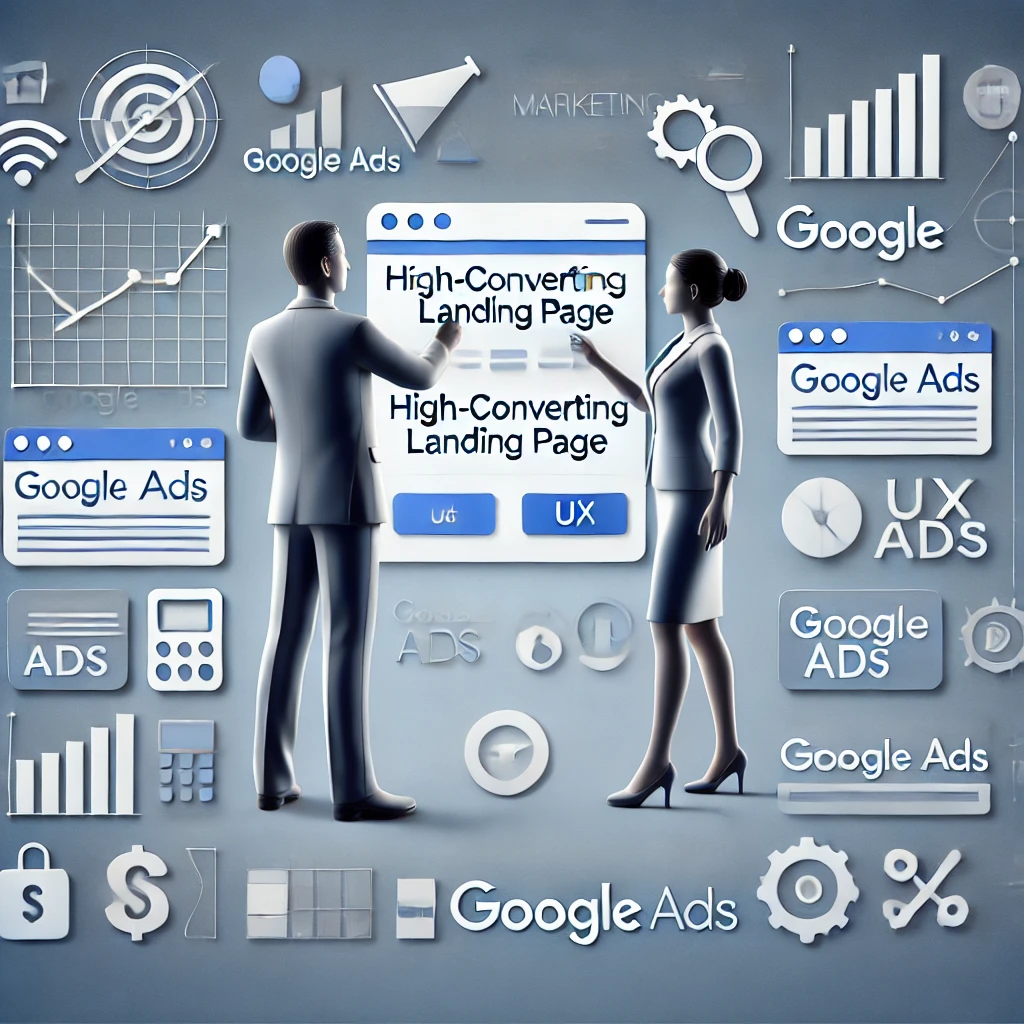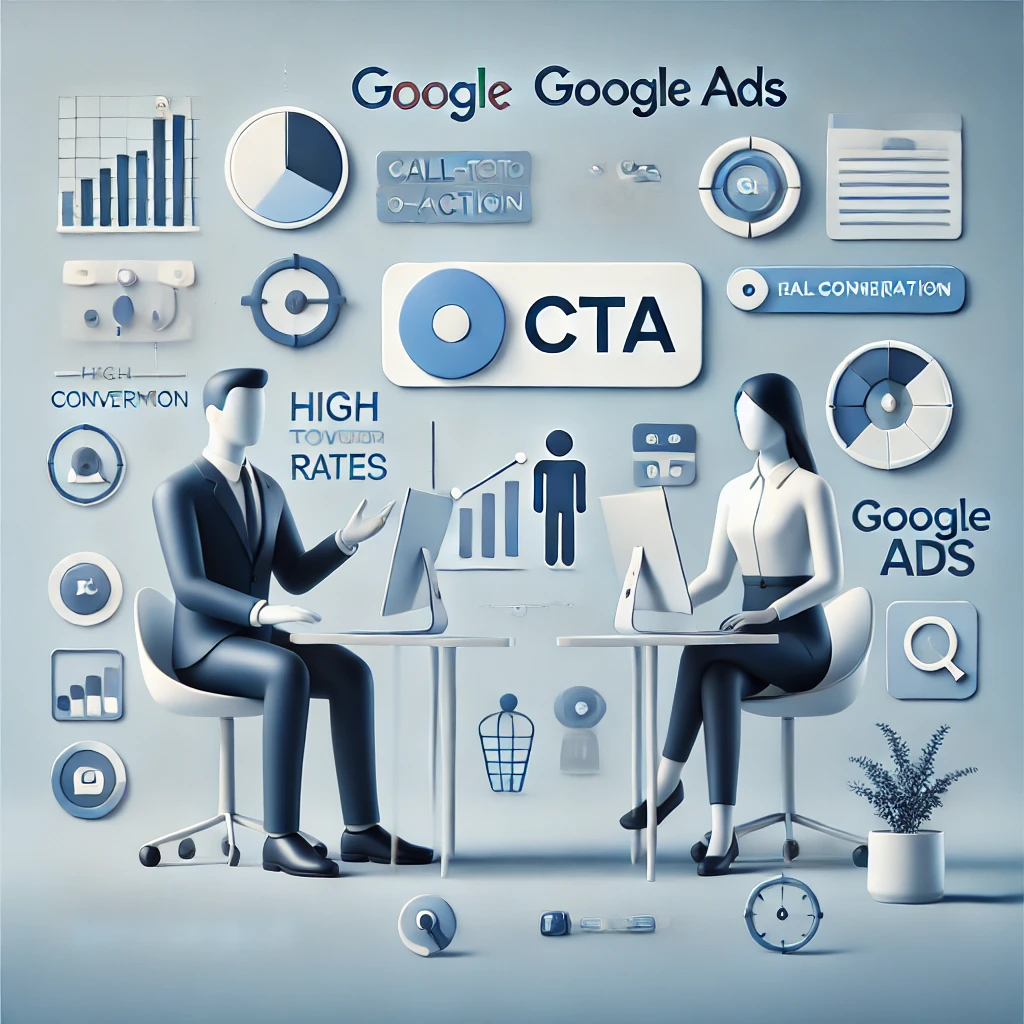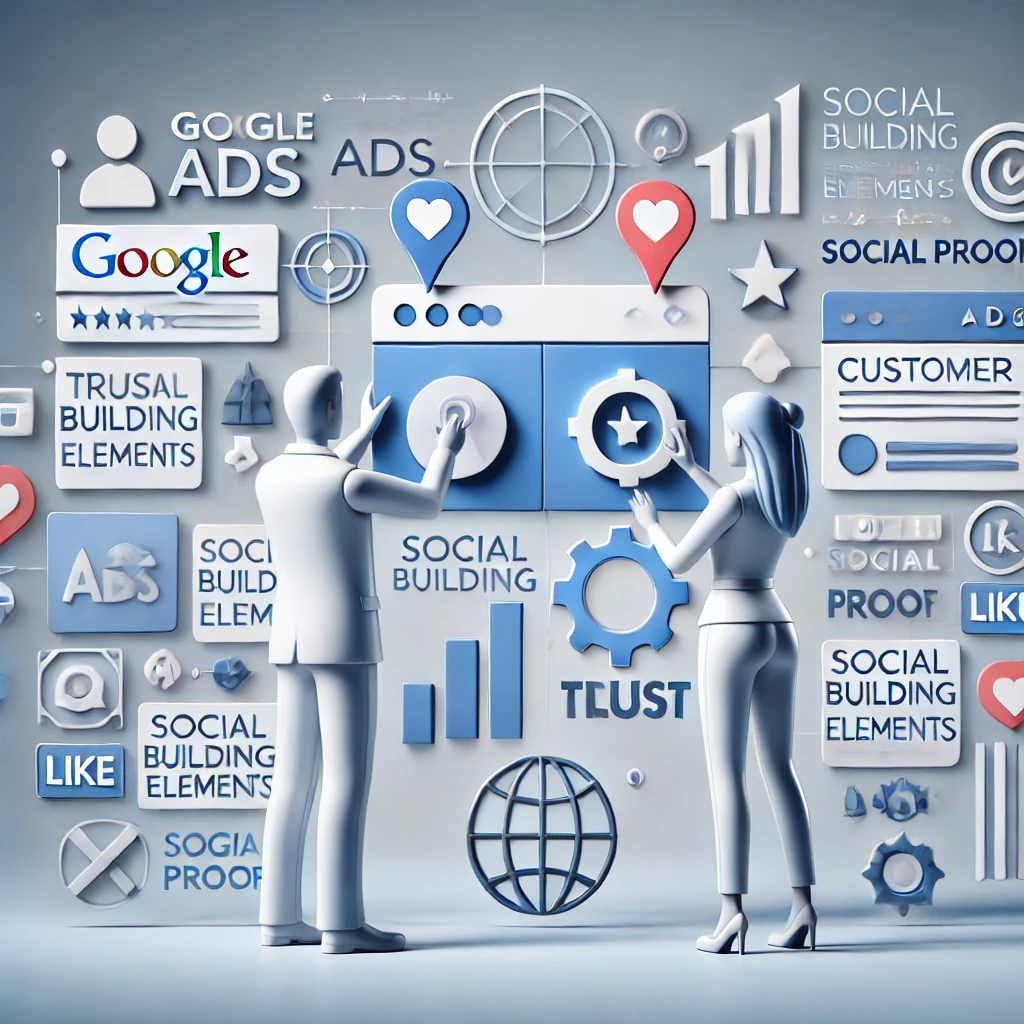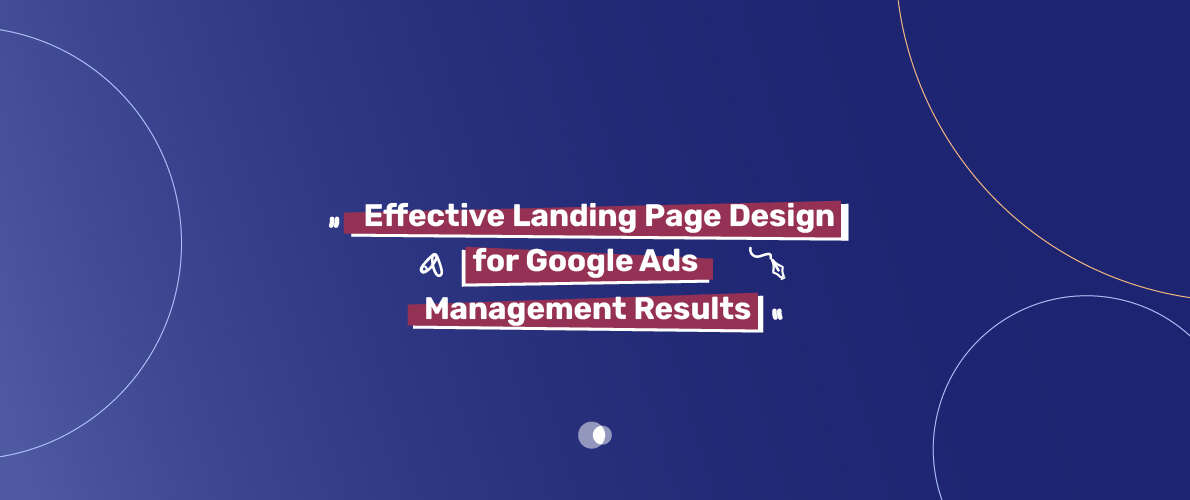In the fast-paced world of digital marketing, the success of PPC campaigns depends a lot on the landing pages they lead to. Good landing page design is key to boosting conversions, cutting down on bounce rates, and increasing the return on investment (ROI) for Google Ads. This section will dive into the basics of making landing pages that work well with your PPC ads.
Table of Contents

Key Takeaways
- Understand the key elements of high-converting landing pages for PPC campaigns
- Discover the importance of user experience in landing page success
- Learn about mobile-first design principles for landing page optimization
- Explore strategies for creating compelling value propositions that drive conversions
- Optimize landing page load speed and performance to improve user engagement
Understanding the Fundamentals of Landing Page Design for Google Ads Management
Making a good landing page is key to getting more from your Google Ads. A great page has a clear headline, nice visuals, and short, persuasive text. This helps visitors move smoothly through the process, making your marketing better.
Key Elements of High-Converting Landing Pages
A top landing page grabs your attention with a strong headline. It also has nice pictures and a simple layout. Plus, clear and short text that solves problems and shows benefits is crucial for getting people to act.
The Role of User Experience in Landing Page Success
User experience (UX) is vital for landing pages. Easy navigation, clear content, and a smooth process make for a better experience. This increases the chance of visitors doing what you want, like buying or signing up.
Mobile-First Design Principles
Today, mobile is everything. Your landing pages need to work well on phones and tablets. This makes sure more people can see and use your content, no matter where they are. By focusing on mobile, you ensure a great experience on all devices.
| Key Element | Description | Impact on Conversion Rate |
| Headline | A clear, attention-grabbing headline that communicates the unique value proposition | High – A compelling headline can instantly capture the visitor’s interest and encourage them to engage further. |
| Visuals | Complementary imagery and a clean, uncluttered layout | High – Visually appealing and user-friendly design can enhance the overall user experience and make the landing page more inviting. |
| Copy | Clear and concise copy that addresses the visitor’s pain points and highlights the benefits of the offer | High – Persuasive and benefit-driven copy can effectively guide the visitor through the conversion funnel. |
| Mobile Optimization | A responsive and mobile-friendly design that ensures a consistent user experience across all devices | High – With the majority of web traffic coming from mobile devices, a mobile-first approach is essential for maximizing conversion rates. |
By following these key design principles, you can make landing pages that work well. This boosts your Google Ads and overall marketing success, leading to better returns on investment.
“Effective landing page design is not just about aesthetics; it’s about crafting a seamless and intuitive user experience that guides visitors towards the desired conversion action.”
Creating Compelling Value Propositions That Drive Conversions
In the digital marketing world, making a unique selling proposition that speaks to your audience is key. Your value proposition should clearly show the customer benefits and what makes your brand stand out.
To make a strong value proposition, first list your product or service’s main features. Think about how these features help your customers. Use this to create a short, catchy statement that shows your brand differentiation.
“A strong value proposition is the foundation of any successful marketing campaign. It’s the heart of your unique selling point and the key to driving conversions.”
Make sure your value proposition is easy to find on your landing page. It should match the ad copy and keywords that brought people to your page. This match, called “message match,” makes your offer seem more relevant and trustworthy, which can increase conversions.
| Effective Value Proposition Elements | Examples |
| Clearly states the primary benefit | “Lose weight effortlessly with our revolutionary fat-burning supplement” |
| Highlights the unique selling proposition | “Become a published author in just 30 days with our guided writing program” |
| Conveys the brand’s competitive advantage | “Experience the fastest, most reliable cloud storage solution on the market” |
By creating a compelling value proposition, you’ll show your unique selling proposition, customer benefits, and brand differentiation. This will help you optimize your landing pages for better conversions.
Optimizing Landing Page Load Speed and Performance
In the world of Google Ads, how fast your page loads is key. A quick website makes users happy and helps your ads perform better. This is because a fast site can improve your Google Ads Quality Score.
Technical Optimization Techniques
To make your page load fast, use several technical tricks. Cut down on HTTP requests and use browser caching. Also, optimize your code and server settings. And, use content delivery networks (CDNs) to get static assets quickly.
Speed Testing Tools and Metrics
Use tools like Google PageSpeed Insights to check your page’s speed. Look at page load time, First Contentful Paint, and Largest Contentful Paint. These are important for the Core Web Vitals.
Image Optimization Strategies
- Use image compression to make files smaller without losing quality.
- Choose modern image formats like WebP or AVIF.
- Lazy load images to only load when needed.
- Use responsive design for images that fit any screen size.
Focus on making your pages load quickly. This will attract more visitors and meet Google’s standards. It will also help your Google Ads campaigns do better.
| Optimization Technique | Potential Impact |
| Minimize HTTP Requests | Reduces overall page load time by decreasing the number of resources that need to be loaded. |
| Leverage Browser Caching | Allows returning visitors to load the page faster by retrieving previously cached assets. |
| Implement Content Delivery Network (CDN) | Serves static assets from the nearest server location, reducing latency and improving overall performance. |
| Optimize Image Compression | Reduces image file sizes without compromising visual quality, resulting in faster page loads. |
“Optimizing your landing page’s load speed is one of the most effective ways to improve user experience and boost your google ads management company.”
Designing Clear and Persuasive Call-to-Action Elements
Making effective call-to-action (CTA) elements is key in landing page design. A good CTA can really boost your conversion rates. It helps more visitors move through the sales funnel. When designing CTAs, paying close attention to detail is vital.
To make a strong CTA, start with clarity. Your CTA button should clearly tell users what to do, like “Sign Up Now” or “Get Your Free Trial.” Stay away from vague phrases like “Click Here,” as they don’t motivate users to act.
Where you place your CTA matters a lot. Put it at important points in the conversion funnel to match the user’s journey stage. For instance, a CTA at the top might encourage learning more, while one at the bottom could push for a purchase.
Make your CTA button design pop by focusing on size, color, and font. A button that grabs attention can boost CTA design and click rates. Also, try different CTA designs through A/B testing to find the best one.

A good CTA isn’t the same for everyone. Customize it based on your audience, product, and landing page goals. By perfecting CTA design and button optimization, you can maximize your conversion funnel and get more conversions.
Implementing Effective Visual Hierarchy and Layout
Visual hierarchy and layout are key in landing page design. They help grab user attention and guide them through the page. Designers use these elements to make the page both beautiful and easy to use, leading to more conversions.
Color Psychology in Landing Page Design
Colors can make people feel certain ways. By using color psychology, designers pick colors that match the brand and what they want users to do. For instance, blues and greens can make users feel safe and stable. On the other hand, reds and oranges can make them feel urgent or excited.
Typography Best Practices
Good typography makes a landing page easy to read and look at. Designers should choose clear fonts, use the right font sizes, and keep text organized. This helps users follow the text easily and enjoy reading it.
White Space Utilization
- White space helps balance the page and focus attention on key elements.
- Using white space around important parts like the main message and call-to-action makes the page clean and easy to read.
Designers who understand visual hierarchy, color psychology, typography, and white space can make landing pages that work well. These pages grab users’ attention and help with Google Ads management, leading to better results.
Crafting Trust-Building Elements and Social Proof
In the digital marketing world, trust is key for success. Your Google Ads landing page is a crucial spot to build trust. Adding trust elements and social proof can make a big difference.
Customer testimonials are a great way to build confidence. Sharing real success stories from happy clients shows the value of what you offer. Include names, job titles, and photos for authenticity.
Trust badges and security seals also help a lot. They show your website is safe and trustworthy. This makes visitors feel more comfortable about buying or sharing their info.
Highlighting your credibility indicators is another smart move. This includes awards, media mentions, or partnerships with big brands. It shows you’re a leader in your field and adds to your value.
| Trust-Building Element | Benefits |
| Customer Testimonials | Showcase real-life success stories, build social proof, and increase conversions. |
| Trust Badges and Security Seals | Reassure visitors about the security and trustworthiness of your website, reducing hesitation. |
| Credibility Indicators | Establish your business as an authority in the industry, reinforcing your value proposition. |
By adding these trust elements and social proof to your Google Ads landing page, you’ll make it more appealing. This can lead to more conversions and a stronger connection with your customers.

A/B Testing Strategies for Landing Page Optimization
Creating effective landing pages is key to boosting conversions and ROI from Google Ads. A/B testing is a powerful way to improve your landing pages. It helps you find out what works best by comparing different versions.
Testing Methodologies
A/B testing, or split testing, means making two versions of a landing page. You then send some website traffic to each version. This lets you see which design, content, or user experience boosts conversions the most.
Key Metrics to Track
- Conversion rate: The percentage of visitors who complete your desired action, such as making a purchase or filling out a lead form.
- Bounce rate: The percentage of visitors who leave your landing page without taking any further action.
- Time on page: The average time users spend on your landing page, which can indicate engagement and interest.
- Click-through rate (CTR): The percentage of visitors who click on your call-to-action (CTA) or other key elements.
Implementation Tools
Many tools help with A/B testing for landing pages. Google Optimize, Optimizely, VWO, and Adobe Target are popular choices. They offer easy-to-use interfaces, advanced testing features, and detailed analytics for your design efforts.
By using a systematic A/B testing approach, you can keep improving your landing pages. This leads to higher conversion rates. It helps you get better results from your conversion rate optimization, split testing, data-driven design, and user behavior analysis efforts.
Maintaining Message Match Between Ads and Landing Pages
Creating a seamless user experience is key for your Google Ads campaign’s success. Keeping ad relevance and consistency between ad content and landing page messaging boosts your Quality Score. It also meets user expectations.
When a user clicks on your ad, they expect to see a landing page that matches the ad’s promise. If the messaging and visuals don’t match, it can cause a bad experience. This leads to higher bounce rates and lower conversion rates.
- Make sure your ad copy and landing page headline use similar language and tone for a smooth transition.
- Match the visual branding, color scheme, and imagery in your ads to the landing page design.
- Highlight the same key benefits, offers, or calls-to-action as in the ad.
- Address any specific pain points or questions raised in the ad content.
By keeping your messages consistent, you improve ad relevance and user experience. This leads to higher Quality Scores and better campaign performance. Spend time creating a cohesive journey from ad to landing page to get the most out of your investment.
| Metric | Importance | Impact |
| Quality Score | High | Directly affects ad rank and cost-per-click |
| Conversion Rate | High | Determines the success of your campaign |
| Bounce Rate | High | Indicates poor user experience and lack of relevance |
Maintaining message match between your ads and landing pages is vital for google advertising agency. By ensuring a seamless and relevant user experience, you can boost your Quality Score. This drives higher conversion rates and maximizes your advertising return on investment.
Conclusion: Maximizing ROI Through Strategic Landing Page Design
When it comes to Google Ads success, your landing page design is key. It helps boost conversions and return on investment (ROI). By using the tips from this article, you can make landing pages that grab your audience’s attention. They will offer a smooth experience and help your PPC efforts.
Creating a strong value proposition and fast load times are crucial. So are clear call-to-action elements. Also, make sure your landing page fits with your digital marketing strategy. This ensures a consistent brand message for your customers.
Improving your landing page design is a continuous effort. Use data to guide your decisions and keep testing. Stay in touch with what your audience wants. This way, your business can grow and thrive in the digital marketing world.
FAQ
1)What are the key elements of high-converting landing pages?
High-converting landing pages have clear headlines and appealing images. They also have concise copy and strategic white space. Plus, they have prominent call-to-action (CTA) buttons.
2)How important is user experience in landing page success?
User experience is key for landing page success. A smooth user flow and easy navigation matter a lot. A mobile-friendly design also boosts conversion rates and lowers bounce rates.
3)What are some techniques for creating compelling value propositions?
To create compelling value propositions, highlight what makes you unique. Show clear customer benefits and stand out from competitors. Make sure your value propositions match your ad copy and keywords.
4)How can I optimize landing page load speed and performance?
To improve landing page speed, use technical optimization and speed testing tools. Optimize images to speed up page load times. Faster pages enhance user experience and Google Ads Quality Score.
5)What best practices should I follow for designing effective call-to-action elements?
For effective CTAs, use clear and actionable copy. Place CTAs strategically and align them with the user’s conversion stage. This boosts click-through rates.
6)How can I leverage visual hierarchy and layout to enhance landing page design?
Use color psychology, typography, and white space to enhance your landing page. These elements guide user attention and improve the page’s look.
7)What are some ways to build trust and incorporate social proof on my landing page?
Build trust by showcasing customer testimonials and trust badges. Use other credibility indicators to boost user confidence and drive conversions.
8)How can I implement A/B testing to optimize my landing page performance?
Use A/B testing to improve your landing page. Define testing methods, track metrics, and analyze data. Continuous testing boosts Google Ads ROI.
9)Why is message match between ads and landing pages important?
Message match ensures a smooth user experience. It meets user expectations and improves ad relevance. This boosts Google Ads Quality Score and campaign performance.



